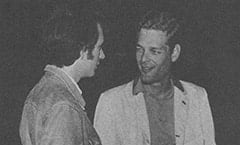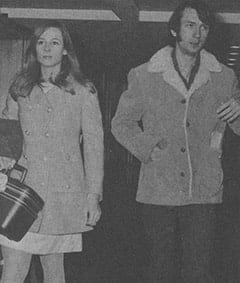
The Mike Nesmith you see on your TV screen is a zany kook. But this isn’t the real Mike. Off the Monkee set he’s different…
It was rehearsal time, scant days before shooting was to begin on the very first segment of the new series, and the four young men who make up The Monkees were rehearsing, practicing, learning and getting accustomed to working together for the new NBC-TV show. The director singled out the tall boy wearing the green knitted hat.
“Let’s work on facial expressions, Mike,” he suggested. “Give me a strong, silent look.” Mike complied.
“Now, change that and give me a girlish look,” was the next request. Mike thought a minute, tried to put himself in a female frame of mind and adopted a soft expression.
“Hey,” said the director, “are you trying to look like a girl?” Mike nodded affirmatively. “I can’t see the difference. Your girl look is the same as the strong, silent look,” complained the director. Mike shook his head slowly and sadly. “That’s your hang-up, man,” he sympathized.

Mike was not being a smart aleck—and the director accepted the remark in the way it was intended. That is Mike’s way. In his mind he changed his expression upon command. If the director couldn’t see the difference, it was the director’s problem, not Mike’s.
Lanky, casual, quiet Mike is quite different from the other three Monkees. He is the tallest (6'1"), the oldest (23) and the only one married (he lives with his wife, PHYLLIS, and their nearly 2-year-old son CHRISTIAN, on a hilltop in West Hollywood). He is liable to come up with totally unexpected answers to questions. An interview with Mike can produce such humorous dialogue as:
“What did you do before you became a folk singer, Mike?”
“I was a failure.”
“Did you work?”
“I worked at being a failure.”
“Are you a kook?”
“Do you think I am?”

This sharp sense of humor generally takes new acquaintances by surprise, for Mike generally wears a solemn, almost unhappy expression. One expects serious answers and sedate behavior to emanate from inside the lugubrious facade. Yet Mike is more likely to utter a croaking sound when the director yells “Quiet” at the start of a scene than to obey—and then mumble, “Ah, shucks. Nobody likes my frog sound,” when he finds no one paying any attention to his prankish attempt at getting a laugh. And he is prone to inject his sharp wit into otherwise serious conversations, such as the time a publicist asked the group, “Where do you guys think we should hold a press conference?” Various suggestions were made, concluding with Mike’s straight-faced comment that he’d like to see it done at a nearby hamburger stand. Asked why there, he explained, “Let’s put on airs.”
None of those actions or conversations show the real Mike Nesmith. Hidden deep behind the false front of a caustic, kooky character is a sensitive, serious-minded, deep-thinking individual that only appears when he is comfortable, when he is certain that the audience to which he will be revealing his true identity is not bent on putting him on or putting him down.
Tendering friendship to Mike is like offering a tidbit to a deer. He will cautiously move toward the outstretched hand, willing to accept the profered [sic] favor but tensely ready to turn and flee at the slightest sign of hostility. Mutual acceptance and understanding produces keen insights in to this sensitive soul such as his statement that, “I believe in the basic goodness of people. That’s because I’m a member of the Christian Science Church.”
Musical leader of The Monkees and composer of some of the tunes they recorded for their first album, Mike is somewhat of a Johnny-come-lately to the music world. He didn’t even have too much interest in music until he was given a guitar for Christmas when he was 19 and attending San Antonio College. Unable to read music, he began writing his own songs.
“I got tired of just going plunk, plunk, plunk on the darn thing,” he explains, “so I made up a little song.” The songs he “made up” and the way he performed them attracted the attention of his classmates and soon he was in demand for folk-singing appearances around the school. After graduation he moved to Los Angeles, teamed up with a bass player and embarked on a road tour that saw them traveling as much as 200 miles a day to an engagement where they would give five performances daily. The experience was valuable, though not too profitable, and when they returned to California they decided to expand to a trio by adding a drummer so they could break into the rock’n’roll field.
All the while Mike continued to write music and soon he polished his songwriting talents beyond his original ability to make up simple folk songs. It wasn’t long before a draft summons broke up the trio and Mike went out on his own as a solo performer. He auditioned at Randy Sparks’ folk club, Ledbetter’s, and got a job which quickly made him a favorite with the students at nearby UCLA who make the club their hangout. While there he heard about the auditions being held for The Monkees, meandered into Hollywood to Screen Gems Studios to see about it and was quickly recognized as a “natural Monkee.” The green wool knit cap he wears on the show is the one he wore into the studio for the audition.
Mike has very strong feelings about today’s music, especially the so-called protest songs. “To urge change just for the sake of making a change is altogether wrong. You have to change bad things and try to make them good things. But whether you change anything or not, I think that seeing kids of 13 and 14 being aware is groovy. It has got to help make them better adults—and sooner. It’s all part of the pioneer spirit that’s so rampant in the United States today. Our late president JOHN F. KENNEDY was really the embodiment of that spirit. I’m a Republican, but I have to admit he was the greatest.”
For a self-taught musician, Mike has some remarkably advanced musical ideas.
“I’m in a whole new musical bag,” he says matter-of-factly, without a trace of boasting. “The music I’m writing now is different. Simple. It’s something that will have other musicians saying, ‘Now why didn’t I think of that?’
“What is it? I call it Country-Latin. You know, I believe music is America’s only real contribution to culture. And the only progressive music today is Latin. Like the stuff that ANTONIO CARLOS JOANBIM plays. You know, bossa nova and like that. So I’ve combined those two sounds. I wasn’t sure they would marry, but by the time we finished working out the harmonies we came up with what I feel is a very exciting sound. It’s somewhat of a monotone, but it’s basically pleasing.”
As he speaks of his music, lights dance in Mike’s eyes, providing an interesting counterpoint to his solemn face.
“The rest of the guys in the group are pretty excited about it, too,” he offers, the sits back to reflect for a moment and abruptly changes the subject.
Answering that ad was undoubtedly the most important single action Mike has ever taken, from the standpoint of career. Although he was becoming popular at Ledbetter’s, he now has a change with The Monkees to become a very big star, both as an actor and as a musician. As a married man with the responsibility of wife, home and child, he obviously could not be more thrilled at the change for financial security.
As far as his career is concerned, the other Monkees look to his leadership on the bandstand; setsiders are amazed at his natural acting ability.
And now total success has come along, long, lead, dour, soft-spoken, shaggy-haired, philosophical Mike Nesmith has been able to meet it head-on, handle it confidently and keep it in its proper perspective. He’s certainly no wise guy. But he’s wise beyond his years.



